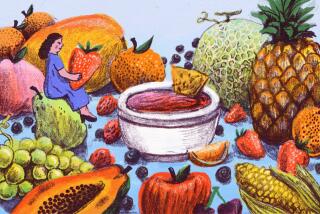IN THE KITCHEN : Let Fajitas Be Fajitas
- Share via
Modern chefs play fast and loose with labels, and in most cases that’s just fine with me. If someone wants to serve tuna carpaccio, as long as it tastes good, far be it from me to point out that carpaccio is made only with beef. The same thing is true for mint pesto. Everyone knows pesto is made from basil. So you’ve got this green smeary stuff that tastes like mint and you think people will try it only if you call it pesto? No problem.
But they never should have messed with fajitas.
Today, everyone knows fajitas--or thinks they do. It’s that tangled mess of meat and vegetables that comes to you on that really neat sizzling, smoking plate. You wrap it up in tortillas and eat it. As such, it is kind of a four-way parlay of a dish, involving two cuisines. The tortillas are definitely Mexican, but the cooking (basically, a marinated-stir fry) is Chinese, including the hot plate (from sizzling rice soup) and the method of eating (more like moo-shu pork than anything else).
It seems that almost anything can qualify for fajitas: pork, sirloin, shrimp, fish, chicken, even tofu. . . . And they show up in the weirdest places. You can find fajitas on menus from Boston to Bakersfield. I once walked into an upscale grocery store and found that fully a third of the meat department was taken up with various kinds of fajitas for marinating in trays. That’s going a bit too far.
*
What has happened here is perhaps the food world’s greatest example of selling the sizzle. The thing people love most about fajitas is the way they come out popping and hissing on the black iron tray.
Well, it may be good marketing, but it’s lousy food (its raging success, of course, only points out which side the food industry’s bread is buttered on).
I happen to have a long and affectionate relationship with fajitas that dates back a couple of decades to summers spent in south Texas. Come a weekend evening, odds were you could find a party where someone was grilling fajitas, or roasting cabrito , and serving it with lots of good local beer and--if you were really lucky--some pretty good music.
Real fajitas are a cowboy dish from the area around the King ranch (for those of you who aren’t from around there, the King ranch actually takes up a sizable chunk of south Texas--825,000 acres, in fact--stretching from near Houston almost to the Mexican border).
*
Fajitas are made from ragged triangles of skirt steak that are marinated in lime juice and jalapeno chiles, grilled all in a piece and then sliced thinly and served on a warm corn (or sometimes flour) tortilla with appropriate salsas. According to Rick and Deann Bayless’ “Authentic Mexican,” there is a corresponding Mexican dish from Sonora called arrachera al carbon . This is not surprising, since in this part of Texas, most of the cowboys are Mexican.
Skirt steak used to be ridiculously cheap. The diaphragm muscle of the cow, it is thin and extremely sinewy. In fact, it is downright chewy (something these ersatz fajitas almost never are). But at the same time, the skirt steak (like other hard-working cuts) is extremely flavorful. And that’s why it’s no longer so inexpensive.
So what you’ve got here is a fragrant, tender tortilla wrapped around thin, chewy strings of tangy, beefy meat. Slather on a little guacamole, and maybe some pico de gallo and, man, that is something that is too good to mess with.
REAL FAJITAS 1 pound skirt steak, whole Salt 1 jalapeno chile, seeded and minced Juice 1 lime 12 corn tortillas, warmed Pico de Gallo Salsa Guacamole
Lay skirt steaks on work table and check closely, removing any “silverskin.” Salt lightly on both sides. Put in sealable plastic food bag with jalapeno and lime juice and refrigerate 1 hour to overnight.
Remove from bag and pat dry with paper towels. Grill over hot charcoal, about 4 to 5 minutes. Turn and grill another 3 to 4 minutes on second side. Remove to cutting board and cut in thin strips.
Divide meat among warmed tortillas and garnish with 1 tablespoon Pico de Gallo Salsa and/or 1 tablespoon Guacamole. Makes 12 tacos.
Each taco contains about: 126 calories; 163 mg sodium; trace cholesterol; 6 grams fat; 17 grams carbohydrates; 3 grams protein; 1.77 grams fiber.
Pico de Gallo Salsa 1/2 white or red onion, minced 2 Roma tomatoes, seeded and chopped 1 clove garlic, minced 1 serrano chile, minced 1 tablespoon minced cilantro Juice 1/2 lime
Combine onion, tomatoes, garlic, chile, cilantro and lime juice in small bowl and mix well. Makes 2 cups.
Guacamole 2 ripe avocados, halved, seeded and scooped from skin 1/2 teaspoon garlic salt Juice 1/2 lime
In small work bowl, mash avocados with fork, leaving small chunks. Sprinkle with garlic salt and lime and stir. Makes 1 1/2 cups.
More to Read
Eat your way across L.A.
Get our weekly Tasting Notes newsletter for reviews, news and more.
You may occasionally receive promotional content from the Los Angeles Times.











